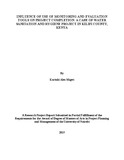| dc.description.abstract | Monitoring and evaluation systems are fundamental tools that ensure projects are completed on time.
They are also aimed at checking whether projects’ scope¸ quality¸ objectives and goals are achieved.
M&E systems improve the overall efficiency and effectiveness of project planning, management and
implementation. On the other hand, many of the projects funded by donors and the government do
not get to see the full implementation or operationalization of their outputs. Money gets wasted,
swindled away¸ and donors stop their funds from supporting local projects. Those projects that
survive do not last for a longer time. This has brought the need to check what else can be done to
effectively gain donors confidence as well as involving all stakeholders. Due to this¸ the researcher
has explored ways to address concerns raised above. The research has also come up with ways on
what else can be done to make sure projects are completed within the stipulated time frame and
working closely with all stakeholders. This study was investigating influence of use of monitoring
and evaluation tools in completion of WASH projects in Marafa Division in Kilifi County. This
study was guided by four main M&E tools namely: the Logical framework¸ Budget allocation
¸stakeholder’s involvement and Human Capacity. The study was guided by the following objectives:
to establish to what extent the use of logical framework influences completion of WASH projects; to
establish how budgetary allocation influences the completion of WASH projects; to examine the
extent to which stakeholder’s involvement influences the completion of WASH projects; to establish
how human capacity influences the completion of WASH projects The study was carried out in
Marafa Division which has four sub- counties. The study target population was 150 respondents
(including 30 CGS¸ 20 staff and 100 community members) out of which a total of 126 participants
responded (consisting of 20 staff, 9 CGS, 9 GOK staff, 8 community guides and 80 community
members) giving a response rate of 86%. The data was collected by use of questionnaires, face to
face interviews and through a checklist. The data was collected by use of the following instruments a
questionnaire, an interview guide and a checklist booklet. Questionnaires were used to collect data
from sampled groups represented by staff and community members. Primary data from the field was
analysed first through the use of SPSS software, MS Excel and PERT tools. A further coding and
questionnaire translation was done by use of MS Project package. Quantitative data will be collected
and analysed by descriptive statistics while a content analysis technique will be used to analyse
qualitative data. The analysed data will be presented in form of tables. Quantitative data was
collected and analysed by descriptive statistics while a content analysis technique was used to
analyse qualitative data. The analysed data was presented in form of tables. The study found out that
60% of the respondent believes that logical framework contributes immensely to WASH projects
completion¸ it also highlighted that 88.9% of the respondent insisted that budgetary allocation
contributes to WASH projects completion. 83.3% believed that stakeholder’s involvement helps in
completion of WASH projects and 53.2% believe that human capacity contributes to completion of
WASH projects. In view of its extensive involvement in agricultural water projects¸ this study
concluded that there is need to incorporate all the above M&E tools to ensure project completion. It
specifically highlighted the need for participatory analysis with all stakeholders onboard. The study
further recommended that all the Tools will be based on the results framework and the communities
involved should be trained and empowered with skills in order to have the knowledge to carry on
with the water projects. There was also the fact that the county government had some similar projects
going on, in line with this¸ the study proposed a steering committee involving all stakeholders to be
constituted to foresee WASH projects implementation in Marafa Division to prevent duplication of
activities. It was also recommended that the local NGOs to spend time with the locals so that they
can train them on the required technical skills. Some locals seemed to have no clue of what was
going on. | en_US |



